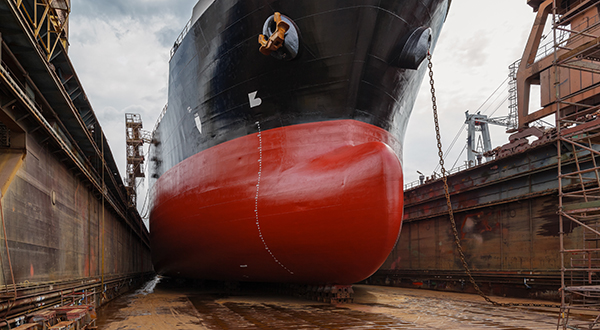While retaining the same yield and tensile strength and weldability as conventional steels, highly ductile steel (HDS) is distinguished by greater ductility. The consequence is that HDS plate has been shown to be able to absorb significantly more energy than its conventional counterpart without rupturing, should it be involved in a 90° collision.
This is clearly significant for ship structures, and HDS is already available from Nippon Steel & Sumitomo Metal Corporation under the NSafe™-Hull brand and has been used in the construction of a Mitsui O.S.K. Lines bulk carrier built by Imabari Shipbuilding Co Ltd. This shipyard, which led the world’s first HDS application, has also taken part in NSafe®-Hull’s development from its initial stage.
The characteristics of HDS are especially significant for tankers, where the regulatory response to historical oil spills has been the enforcement of double-hulled vessels where conventional steel plate is used.
A collision involving an impact at right angles to the hull would be the most probable occurrence and is supposed to cause the most severe damage to the struck ship. However, the crashworthiness of hull structures needs to also be considered in relation to oblique collisions.
The 2001 Baltic Sea collision between the vessel Tern and starboard tank No.6 of Baltic Carrier, which contained 2,700 tons of fuel oil, involved a hull built of conventional steel struck at an angle of incidence of around 50°. Although a double hull vessel, Baltic Carrier was holed, with the main part of the 2,700 tons of oil discharged into the sea.
Currents carried the oil spill towards the Danish islands Moen and Falster, and into the narrow Groensund waters between the two. The pollution along the coastline was the most severe ever experienced off the coast of Denmark.
While such consequences are rare, oblique collisions are not. For this reason ClassNK has supported work on a new series of three-dimensional, non-linear ship-to-ship collision simulations through its Joint R&D for Industry Program. ClassNK is working together with the National Maritime Research Institute, Nippon Steel & Sumitomo Metal Corporation, and Imabari Shipbuilding Co Ltd to quantify the extent to which ships featuring HDS would offer better protection against shell rupture.
A series of finite element simulation was carried out between two very large crude carriers (VLCCs) where a comparison was made covering the same incident scenarios between ships constructed using conventional steel plate and HDS. Both the striking ship’s speed and the angle of collision were varied.
The collision scenario assumes that the striking ship collides with the mid-ship section of the struck ship where damage is the most severe. The output offers a comparison of energy absorbed at a variety of angles of incidence and the way the ‘critical striking velocity’ changes. Critical striking velocity is the maximum impact that could be sustained without the ship’s inner shell being ruptured.
To encompass a higher level of real world factors into the investigation, three types of conventional steel (one mild steel for the bow and side stringer, HT32 (High Tensile Strength Steel 32kn/mm2) for the outer and inner shell, and HT36 for the upper deck and bottom shell) were used. The simulation directly compares different collision scenarios between these steels and their corresponding HDS (HDS, HDS32, and HDS36).
An example of the normalized nominal stress-strain relationships between the two steel types is offered for HT32 and HDS32. In this case, HDS offers elongation one and a half times that offered by high tensile strength steel. This elasticity has a significant bearing on energy absorption.
An investigation of critical striking velocity in the case of an oblique collision with HDS shows that rupture of the outer shell and the inner shell does not occur if the impact force is ≤12 knots, even if the collision occurs at a 90° angle.
In the case of conventional steels, the ‘rupture limit curve’ modelled suggests that a 90° collision generating as little as 3 knots would penetrate the outer shell, with the inner shell being penetrated if the impact velocity was just under 6 knots. If the angle of incidence were 60°, a striking velocity of 7.5 knots would still represent an impact large enough to breach both skins.
The study’s findings are that if the collision angle is 30° or 150°, the striking ship will slip against the struck ship and the two ships float apart from each other, consequently avoiding severe penetration, but if the angle of incidence is 45° or above no such ‘slip condition’ occurs as far as the present study. For the ship built using high tensile strength steel, then, the critical collision angle is therefore somewhere between the two. For the ship built using HDS struck by another with a velocity of 12knots, there would be no critical collision angle at all.
With the practical application of HDS in vessel designs, expectations are high for helping shape a safer future.
Source: ClassNK































































